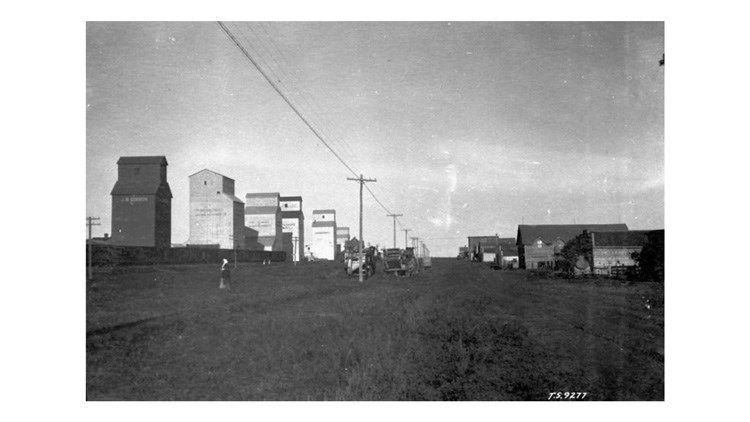(EDITOR’S NOTE: This is the third of three parts of a history of Doukhobor elevators in the Veregin district that was researched, compiled and presented at the National Doukhobor Heritage Village in Veregin on July 16 by Jonathan Kalmakoff, who provided the accompanying photographs.)
Demise of the CCUB and sale of elevators
VEREGIN - For over three decades, the Christian Community of Universal Brotherhood ran a substantial grain elevator business at Veregin. Indeed, in 1921, Veregin boasted the second-largest capacity of any rail point in Western Canada with 355,000 bushels of total capacity; over half of which was accounted for by the Community. In January 1931, the Community’s three elevators and flour mill were valued at $72,000. However, the enterprise was not to last.
In June 1931, the mill elevator and flour mill were destroyed in a fire attributed to arson. At the time, the mill was valued at $40,000, and the elevator at $12,000. Also destroyed were 500 sacks of flour in the mill valued at $1,200 and 5,000 bushels of wheat in the elevator valued at $6,600. It was a devastating blow to the Community.
By this time, the communal organization itself was in desperate financial straits, due to a combination of complex factors, including low prices for its agricultural commodities during the Great Depression, burdensome interest rates on its mortgaged properties, a declining membership that placed the debt load on disproportionately fewer members, enormous losses to its capital assets caused by arson, and financial mismanagement.
In an attempt to satisfy creditors, the Community sold its two remaining elevators at Veregin between 1932 and 1935. However, it proved too little, too late. By 1936 the communal organization was bankrupt and its creditors foreclosed upon its remaining property and assets in 1938.
The elevator west of the remaining one was sold in 1932 to the Northern Elevator Company, which operated it until 1940, when it was taken over by the National Grain Company. In 1951, National enlarged its capacity to 98,000 bushels, and again in 1960 to 120,000 bushels. In 1975, National was bought out by Cargill Grain Co. Ltd. which operated it until 1982. In 1982, it was sold to United Grain Growers, which operated it until 1986. That year, UGG became Pioneer Grain Company Limited, which operated the elevator for a final year until 1987. By the end of the 1980s, it was dismantled.
The elevator that still stands today was sold in 1935 to Federal Grain Limited. In 1951, Federal increased its capacity to 77,000 bushels; and in 1960 to 118,500 bushels. It continued to operate the elevator until 1972 when Federal was bought out by Saskatchewan Wheat Pool. The Wheat Pool continued to operate the elevator until 1984, after which it sat empty.
Purchase by the National Doukhobor Heritage Village
In March 2001, the elevator was acquired by the National Doukhobor Heritage Village, where it stands today, forming one of three original buildings constructed on the site by the Doukhobors. In July 2009, the elevator was designated a National Historic Site, along with the other village structures, with a Parks Canada Plaque acknowledging National Significance of Doukhobors at Veregin. It was designated a Saskatchewan Provincial Heritage Property in August 2018. Due to COVID-19-related gathering restrictions, the unveiling of the commemorative plaque was delayed until July, this year.
Today, the elevator and its interior, annex and office are all structurally solid, but requires new shingles, top windows and replacement of metal siding. The driveway receiving shed is in poor condition. The cement is crumbling and the roof needs replacement. The elevator office building is in good condition with some repair completed in the last 10 years.
As for the elevator’s future, it is the intent of the National Doukhobor Heritage Village to preserve and restore it as a key heritage building because of its historic significance. An Elevator Restoration Committee has been formed for the purpose of fundraising and coordinating the necessary work.
Heritage significance of the Veregin Grain Elevator
Given its history, the Veregin Grain Elevator is provincially significant for a number of reasons. It is historically one of the oldest remaining grain elevators in Saskatchewan, and stands as a reminder of the thousands that once dotted the Prairies and have slowly vanished from the landscape.
It is also culturally significant due to its construction by early Doukhobor pioneers to the region, to its uniquely communal operation by the Community and to being the last Doukhobor-built grain elevator of its kind in existence.
Its heritage value also lies in its form. The Veregin elevator is distinguished by its unique roof design. It is neither the pyramidal design nor hipped-roof design of elevators built during its era. This elevator has its shorter stature, with a wide cupola that is an extension of the building. The cupola also faced east-west, unlike the north-south orientation of the roof cupola of the other former elevators in the village.
In light of this, it is fitting that the elevator is now commemorating with a plaque designating its Provincial Heritage Property status, as the National Doukhobor Heritage Village works towards its ongoing preservation and restoration efforts.




